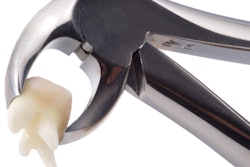
My practice focuses on an underappreciated and underserved segment of the dental population: those with dental anxiety and dental phobia. For most dentists, these aren't the easiest patients. I occasionally ask my peers to send me their most difficult patients, the ones they dread seeing. Most happily refer them.
Dental fear knows no boundaries. It affects all ages, cultures, genders, socioeconomic groups, and ethnicities.
4 fears
I encounter patients daily whose fears and anxieties range from mild to debilitating. Some need a hand to guide them from their car to my treatment room. Others hide under blankets in my waiting room. They have many fears, but four stand out: the fears of pain, needles, lectures, and not being in control.
1. Fear of pain
 Scott Shamblott, DDS.
Scott Shamblott, DDS.We have all heard the question from our patients: "Is this going to hurt?"
I address this from several angles.
The first angle to address is your local anesthetic technique. Are you getting patients profoundly numb and verifying it before you pick up the handpiece? If you start work on fearful patients and they aren't profoundly numb, you lose their trust and they probably won't come back.
I recommend evaluating each situation to determine which local anesthetic technique to use, taking into account anatomic location, level of inflammation, and infection, as well as the patient's level of fear and anxiety.
I recommend nitrous oxide for most patients. It makes such a difference to them -- and to my ability to treat them -- that I don't charge for it. I start the nitrous oxide first, and get the patient to a comfortable level.
Then I administer a topical, and let it work a minute before injecting the local. It's important to let the local work at least 10 minutes. This helps keep the patient calm, and I say this extra time helps the anesthetic do its job. Since the temptation to start is hard to resist, I leave the operatory and do a hygiene check or see an emergency patient.
My assistant stays with the patient, talking about anything but dentistry, and I return 10 minutes later to test the tooth. This is important for building trust.
I prefer to spray some Endo-Ice (Coltene) on a cotton-tip applicator and tell the patient I'm going to see if the area is sufficiently numb. I tell the patient I will touch the tooth with a cold cotton swab and to raise a hand if he or she feels anything cool or cold. If nothing is felt, the patient is numb and ready to go. Otherwise, I add more local, wait 10 more minutes, and retest.
2. Fear of needles
No one likes shots, so I find that distraction is the name of the game. Technique helps, too. I use the same process for fear of pain and add vigorous cheek-pulling while varying the rate and frequency every few seconds.
I give patients something to squeeze, and I get them involved in a discussion about music right before the first injection.
3. Fear of lectures
Do you enjoy being lectured to? Your patients don't like it either. Talk to them and treat
“It's important to shift some control back to the patient.”
them the way you would your best friend or significant other, regardless of their dental IQ and condition of their mouth. Make them think you care by actually caring.Patients rarely understand technical terms and names, and they feel inadequate when they don't understand what you're talking about. Use words your grandmother would understand.
The rare patient who wants more detail will ask. Then talk about everything the patient wants to know.
4. Fear of losing control
Most patients don't articulate this fear, but if you talk to them it becomes apparent. Dentistry is an up-close, in-your-face, and personal-space experience. The doctor is in full control and many patients feel vulnerable.
It's important to shift some control back to the patients. I tell patients to raise their hand if they need me to stop for any reason. And when they do, I stop -- every time. This is important because most test to see if I really will stop. They're surprised and happy when I do. And then -- finally -- they begin to relax.
I give patients breaks at natural stopping points during procedures. Reviewing the planned procedure and answering questions before, during, and after treatment helps give them some control back.
Many dental professionals prefer to avoid high-fear patients, but the rewards of working with them are immense. They rarely have their dental needs met, and the opportunity to make them smile and get them out of pain is great. In addition, when you meet and exceed the needs of high-fear patients, they become your biggest fans. In today's competitive practice environment, you can't have enough patients who are enthusiastic devotees and spread the word about you.
Scott Shamblott, DDS, is a general dentist and the founder of Shamblott Family Dentistry in Hopkins, MN. He is one of 450 dentists worldwide selected to test dental products and techniques for Gordon Christensen's Clinicians Report.
The comments and observations expressed herein do not necessarily reflect the opinions of DrBicuspid.com, nor should they be construed as an endorsement or admonishment of any particular idea, vendor, or organization.



















